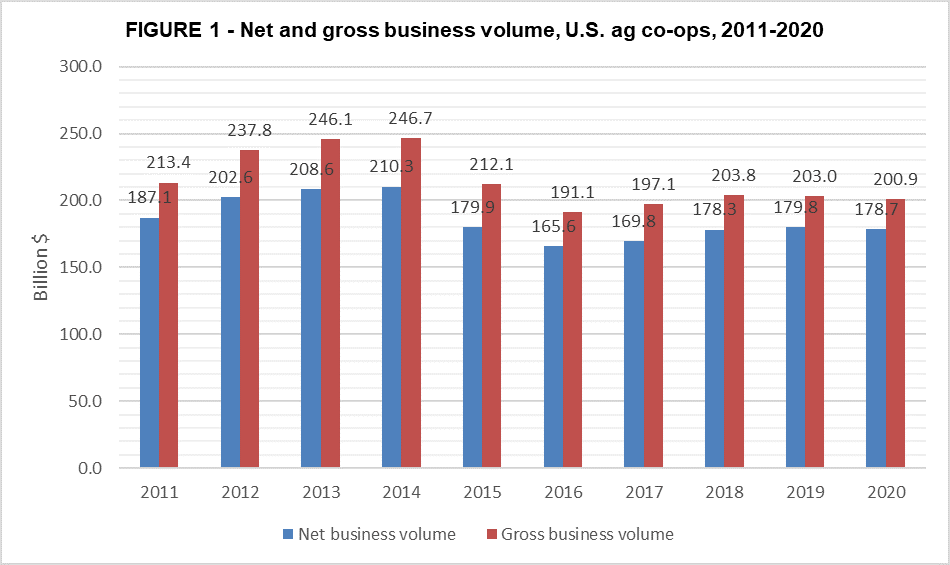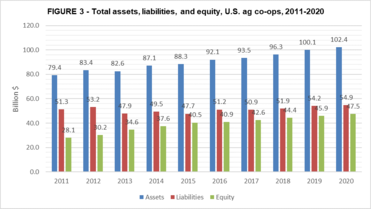
Agricultural Cooperative Statistics Summary, 2020
This bulletin provides a brief summary of cooperative statistics from USDA’s annual survey of the Nation’s agricultural cooperatives for fiscal year 2020.
December 16, 2021
Revenue dips, but co-ops set asset and income records
USDA’s annual survey of the nation’s 1,744 farmer, rancher and fishery cooperatives shows that while total gross revenue dropped for the second straight year, net income increased for the third straight year and hit a record $8.4 billion in 2020 (Figures 1 and 2). Some specific findings from the aggregated income statement for 2020 include:
- Marketing sales by co-ops increased 1.0 percent from 2019 to $126.3 billion, while supply sales decreased from $71.0 billion to $67.1 billion, a drop of 5.6 percent. Service receipts and other operating income increased slightly, by $22 thousand, but with all combined, gross operating revenue dropped by 1.3 percent to $198.6 billion.
- Cost of goods sold decreased 2.1 percent which resulted in an increase of 1.3 percent in net operating revenue ($28.6 billion).
- Total expenses increased by 4.6 percent with wages up 1.3 percent, depreciation up 4.0 percent, interest down 11.7 percent, and other expenses up 14.2 percent.
- Patronage received and non-operating income both increased, by 11.7 and 30.2 percent, respectively.
- All these factors resulted in a 7.1 percent increase in net income after taxes, to the record $8.3 billion. This net income is important as it allows co-ops to return earnings to members in patronage and equity redemption, and/or to invest further in operational assets for continued prosperity and service to members.
- Total gross business volume – the aggregation of sales, service receipts and other operating revenue, patronage received, and non-operating income – was $200.9 billion, down 1.1 percent from the $203.1 billion experienced in 2019 (Figure 1).
- Return on assets and return on member equity both improved from 2019, and were at 9.3 percent and 29.7 percent, respectively.
 
The combined balance sheet for the Nation’s ag co-ops remained strong, with record assets of $102.4 billion and also record member equity of $47.5 billion in 2020 (Figure 3). Specifically, some aggregated balance sheet findings for 2020 include: |
|
 |
- Assets increased $2.2 billion (2.2 percent) and members equity increased $1.6 billion (3.4 percent). Investments in property, plant, and equipment (fixed assets) by ag co-ops – including grain elevators, warehouses, farm supply stores, petroleum/convenience stores, fertilizer and feed plants, major food and beverage processing plants, etc. – increased, to a record $31.4 billion, up $932 million from 2019.
- Total liabilities increased to $54.9 billion in 2020, up slightly from $54.2 billion in 2019.
- Retained earnings also increased, from $19.8 billion in 2019 to $21.2 billion.
Ag co-op structural characteristics
The number of ag co-ops continues to decline. In 2020, USDA counted 1,744 farmer, rancher and fishery co-ops, down from 1,779 in 2019. In 2020, 915 co-ops (52.5 percent) predominantly marketed commodities, and the other 829 consisted of 742 farm supply co-ops and 87 service co-ops (i.e., those that provide storage, transportation or agronomy services).
While the numbers of ag co-ops have been dropping, those that remain continue to operate more than 9,500 locations across all 50 States. In addition to headquarters, ag co-ops had 7,801 other locations consisting of separate branch facilities, plants, elevators, c-stores, service centers, and other locations in 2020.
Headquarter locations in 49 States
Forty-nine States are home to at least one agriculture cooperative. Four States are home to the headquarters of more than 100 ag co-ops: Minnesota and Texas (with 150), North Dakota (112), and California (101).
In 2020, the number of ag co-ops reporting operations in two or more States was 269, while the remaining 1,475 operate within one State. Minnesota had 192 ag co-ops conducting business in the State, followed by Texas with 175, North Dakota with 135, California with 127, and Illinois with 113.
Iowa was the leading state for co-op net business volume, at almost $17.4 billion (this includes income from all co-ops with operations in a State, not just those with headquarters there). Minnesota ranks second with $16.3 billion, followed by California with $14.1 billion. Then comes Illinois ($10.8 billion), Wisconsin ($9.8 billion), Nebraska ($8.8 billion) and Kansas ($7.6 billion).
Co-op jobs inch upward; memberships dip slightly
Total employment in ag co-ops increased slightly in 2020, up by 1,822 employees from 2019. However, full-time employment fell by 1,356 positions, while part-time jobs increased by 3,178 positions. Co-ops had 136,363 full-time employees in 2020 and 49,094 part-time or seasonal employees, for total employment of 185,457 people.
Producers held 1,868,851 memberships in cooperatives in 2020, a decrease of 1.6 percent from 2019. Not all farmers, ranchers or fishermen belong to a cooperative, but many producers belong to two or more co-ops. For instance, a dairy farmer may market milk through a dairy co-op while buying farm production supplies from a supply co-op, and services through a service co-op.
Co-ops an important mainstay in rural America
Agricultural cooperatives have been a mainstay in rural America since the early 1900s. In 2020, there are 306 co-ops (17.5 percent of all ag co-ops) that were 100 or more years old, 53.6 percent were more than 75 years old, and 76.5 percent were more than 50 years of age. Though fewer in number, co-ops remain an efficient and sound marketing channel for their members’ products, many adding value to products, further benefitting member-owners. Co-ops also continue to provide supplies and services members need to operate farms and ranches in an increasingly dynamic, challenging agricultural environment.
Overall, ag co-ops are well managed, efficient, and financially solid, helping to provide a strong foundation for the viability of the rural communities in which most producer-members live and where many of the thousands of co-op facilities are located. Ag co-ops also boost the economies of many less-rural cities where co-ops may have offices, plants, or other facilities. The overall positive performance of ag co-ops in 2020 shows that the time-tested, member-owned and governed co-op business structure remains as important as ever to America's producers and to its food and fiber system.
|